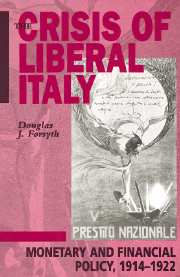Part 2 - World War I, August 1914–November 1918
Published online by Cambridge University Press: 11 December 2009
Summary
The outbreak of the European war in August 1914 produced major realignments in Italy's domestic politics, which would contribute significantly to the post-war crisis of the liberal state. Above all, it created a rift between neutralists and interventionists, confounding the previous left–right political spectrum. Most of the right, after initial hesitation, rallied behind Salandra and Sonnino – who joined the cabinet as Foreign Minister in November 1914 – in support of intervention. The left, in contrast was divided. The Socialist Party, and the leading exponents of the Catholic movement embraced neutrality unreservedly. Giovanni Giolitti tended to oppose intervention in the war as well. While he conceded that Italy's foreign policy aspirations required that it demand compensation from Austria for any gains made by the Habsburg monarchy in the Balkans as a consequence of the conflict, he believed such compensations could be obtained by maintaining armed neutrality. He feared that Italy's political, economic, social, and military structures would prove too fragile to withstand a major war, and he doubted the Entente would prevail quickly over the Central Powers. Austrian intransigence might force Italy to intervene, he conceded, but he felt every effort had to be made to achieve a satisfactory settlement through negotiation first. However reasonable this program may have been, it left the Piedmontese statesman relegated to the political sidelines once war was declared.
- Type
- Chapter
- Information
- The Crisis of Liberal Italy , pp. 61 - 68Publisher: Cambridge University PressPrint publication year: 1993



